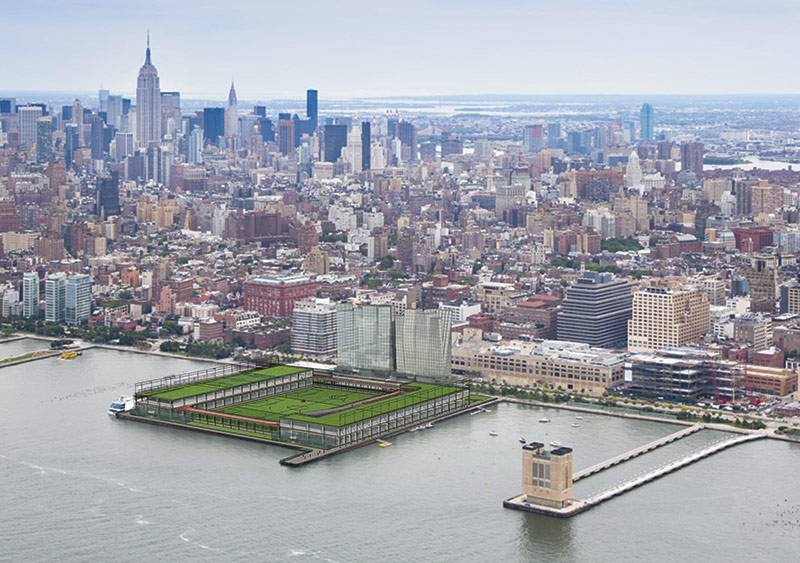
Since May 2012, when the Hudson River Park Trust began seeking suggestions for how to save the deteriorating Pier 40, two competing proposals have come to the fore: one backed by The Durst Organization and designed by Dattner Architects, the other designed by WXY Architecture + Urban Design and backed by the Pier, Park and Playground Association (PPPA), a non-profit that represents seven youth sports leagues and promotes the construction of new ball fields in lower Manhattan.
Originally designed as a passenger ship terminal, the pier is now a revenue generator for Hudson River Park. Home to a commercial parking garage, two athletic fields, and the offices of the Hudson River Park Trust, the pier has raised, on average, $6 million annually from parking fees and has been responsible for 40 percent of the park’s funding. Years of delayed maintenance, however, have severely compromised the pier’s structure. Many of its piles are corroding and the roof has degenerated to the point that several sections of the parking garage have had to be shut down. As a result, the pier is loosing operating revenue.
|
Schematic diagram of Dattner’s Plan (left) and WXY’s plan (right). [Click to enlarge.].
Courtesy Dattner; WXY
|
||
In order to pay for the estimated $30 million it will take to replace the roof, not to mention the cost of repairing the 13 miles of rusting steel piles, the pier needs a new source of income. The two proposals, which are seeking to garner the interest of developers who will see them through, attempt to provide this funding, while preparing the pier for future Sandy-magnitude weather events.
The Durst/Dattner proposal is the most straightforward of the two. “This is basically an enormous midtown skyscraper on its side,” said Daniel Heuberger, a design principal at Dattner. “In and of itself it’s a terrific project. So we’re minimizing the physical interventions in the existing building.” It involves consolidating the parking on one level with stackers and transforming 400,000 square feet of the interior to speculative office space and 90,000 square feet along the Hudson River Esplanade to retail. The scheme would also elevate electrical and mechanical equipment, as well as the playing fields, to above the Sandy storm surge level and add a green roof.
Durst has determined that tech companies would be most interested in the pier. “Large floor plates, unconventional and quirky, close to public transportation—that’s what tech companies want,” said Jordan Barowitz, director of external affairs at Durst. “We think we can get 55 dollars a square foot and we’ve been approached by potential tenants.”
Tobi Bergmann, president of PPPA, disagrees. “We sponsored a study that was done last year by Tishman to look at Pier 40 in terms of what uses can happen that are both high revenue and low impact,” he said. “It made it clear that the only one you could have confidence in is residential.” WXY’s scheme proposes constructing two residential towers at the landside of the pier and removing the existing head house to provide room for another playing field while also improving access to the fields and riverfront from the esplanade. “The new development would help finance the repairs of the pier,” said Claire Weisz, principal of WXY. “At the same time there would be an annual contribution from tenants that would help to generate income.”
The viability of either proposal is contingent upon changes to the Hudson River Park Act. The state legislature would have to update the zoning of the pier to allow either commercial or residential uses and would also have to increase the lease terms to at least 49 years.